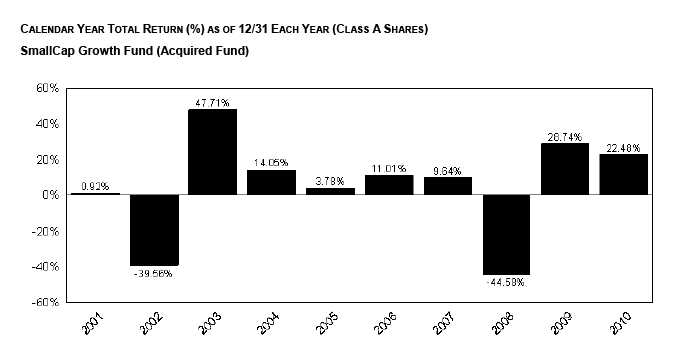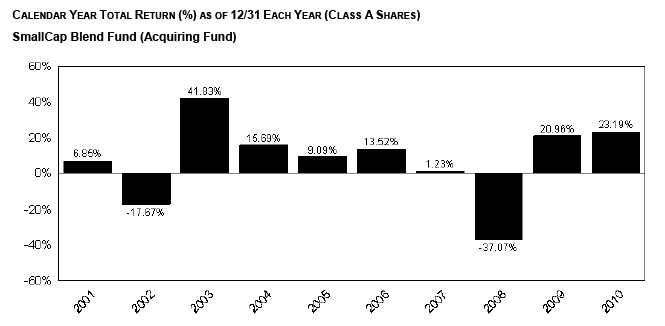|
| Please consider all the factors when you compare the turnover rates of different funds. You should also be aware that the "total |
| return" line in the Financial Highlights section reflects portfolio turnover costs. No turnover rate can be calculated for the Money |
| Market Fund because of the short maturities of the securities in which it invests. |
| |
| Preferred Securities. Preferred securities generally pay fixed rate dividends and/or interest (though some are adjustable rate) |
| and typically have "preference" over common stock in payment priority and the liquidation of a company's assets – preference |
| means that a company must pay on its preferred securities before paying on its common stock, and the claims of preferred |
| securities holders are ahead of common stockholders' claims on assets in a corporate liquidation. Holders of preferred securities |
| usually have no right to vote for corporate directors or on other matters. The market value of preferred securities is sensitive to |
| changes in interest rates as they are typically fixed income securities - the fixed income payments are expected to be the |
| primary source of long-term investment return. Preferred securities share many investment characteristics with bonds; therefore, |
| the risks and potential rewards of investing in the Fund are more similar to those associated with a bond fund than a stock fund. |
| |
| Real Estate Investment Trusts. Real estate investment trust securities ("REITs") involve certain unique risks in addition to |
| those risks associated with investing in the real estate industry in general (such as possible declines in the value of real estate, |
| lack of availability of mortgage funds, or extended vacancies of property). REITs are characterized as: equity REITs, which |
| primarily own property and generate revenue from rental income; mortgage REITs, which invest in real estate mortgages; and |
| hybrid REITs, which combine the characteristics of both equity and mortgage REITs. Equity REITs may be affected by changes |
| in the value of the underlying property owned by the REITs, while mortgage REITs may be affected by the quality of any credit |
| extended. REITs are dependent upon management skills, are not diversified, and are subject to heavy cash flow dependency, |
| risks of default by borrowers, and self-liquidation. As an investor in a REIT, the Fund will be subject to the REITs expenses, |
| including management fees, and will remain subject to the Fund's advisory fees with respect to the assets so invested. REITs |
| are also subject to the possibilities of failing to qualify for the special tax treatment accorded REITs under the Internal Revenue |
| Code, and failing to maintain their exemptions from registration under the 1940 Act. |
| |
| Investment in REITs involves risks similar to those associated with investing in small capitalization companies. REITs may have |
| limited financial resources, may trade less frequently and in a limited volume, and may be subject to more abrupt or erratic price |
| movements than larger company securities. |
| |
| Repurchase Agreements. Repurchase agreements typically involve the purchase of debt securities from a financial institution |
| such as a bank, savings and loan association, or broker-dealer. A repurchase agreement provides that the Fund sells back to |
| the seller and that the seller repurchases the underlying securities at a specified price on a specific date. Repurchase |
| agreements may be viewed as loans by a Fund collateralized by the underlying securities. This arrangement results in a fixed |
| rate of return that is not subject to market fluctuation while the Fund holds the security. In the event of a default or bankruptcy by |
| a selling financial institution, the affected Fund bears a risk of loss. To minimize such risks, the Fund enters into repurchase |
| agreements only with parties a Sub-Advisor deems creditworthy (those that are large, well-capitalized and well-established |
| financial institutions). In addition, the value of the securities collateralizing the repurchase agreement is, and during the entire |
| term of the repurchase agreement remains, at least equal to the repurchase price, including accrued interest. |
| |
| Royalty Trusts. A royalty trust generally acquires an interest in natural resource or chemical companies and distributes the |
| income it receives to its investors. A sustained decline in demand for natural resource and related products could adversely |
| affect royalty trust revenues and cash flows. Such a decline could result from a recession or other adverse economic conditions, |
| an increase in the market price of the underlying commodity, higher taxes or other regulatory actions that increase costs, or a |
| shift in consumer demand. Rising interest rates could adversely impact the performance, and limit the capital appreciation, of |
| royalty trusts because of the increased availability of alternative investments at more competitive yields. Fund shareholders will |
| indirectly bear their proportionate share of the royalty trusts' expenses. |
| |
| Small and Medium Capitalization Companies. Funds may invest in securities of companies with small- or mid-sized market |
| capitalizations. Market capitalization is defined as total current market value of a company's outstanding common stock. |
| Investments in companies with smaller market capitalizations may involve greater risks and price volatility (wide, rapid |
| fluctuations) than investments in larger, more mature companies. Small companies may be less significant within their industries |
| and may be at a competitive disadvantage relative to their larger competitors. While smaller companies may be subject to these |
| additional risks, they may also realize more substantial growth than larger or more established companies. |
| |
| Smaller companies may be less mature than larger companies. At this earlier stage of development, the companies may have |
| limited product lines, reduced market liquidity for their shares, limited financial resources, or less depth in management than |
| larger or more established companies. Unseasoned issuers are companies with a record of less than three years continuous |
| operation, including the operation of predecessors and parents. Unseasoned issuers by their nature have only a limited |
| operating history that can be used for evaluating the company's growth prospects. As a result, these securities may place a |
| greater emphasis on current or planned product lines and the reputation and experience of the company's management and |
| less emphasis on fundamental valuation factors than would be the case for more mature growth companies. |
| |
| Temporary Defensive Measures. From time to time, as part of its investment strategy, each Fund (other than the Money |
| Market Fund which may invest in high-quality money market securities at any time) may invest without limit in cash and cash |
| equivalents for temporary defensive purposes in response to adverse market, economic, or political conditions. To the extent |
| that the Fund is in a defensive position, it may lose the benefit of upswings and limit its ability to meet its investment objective. |
| For this purpose, cash equivalents include: bank notes, bank certificates of deposit, bankers' acceptances, repurchase |




